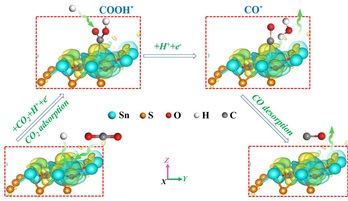Partially Oxidized SnS2 Atomic Layers Achieving Efficient Visible-Light-Driven CO2 Reduction
Solar-driven CO2 reduction to value-added fuels under normal temperature and pressure could help to simultaneously solve the energy issues and environmental problems, whereas the low CO2 conversion efficiency severely hampers its practical implementation. In response to the challenges, Prof. Yi Xie and Prof. Yongfu Sun from University of Science and Technology of China designed a new catalyst of partially oxidized SnS2 atomic layers, whose energy band structures were clearly resolved by the synchrotron radiation photoemission spectroscopy and the X-ray absorption near-edge spectroscopy from National Synchrotron Radiation Laboratory (NSRL). Moreover, surface photovoltage spectroscopy, in situ Fourier transform infrared spectroscopy spectra and density functional-theory calculations revealed that locally oxidized domains confined in SnS2 atomic layers not only benefited for charge-carrier separation kinetics, but also lowered the activation energy barrier through stabilizing the COOH* intermediates, hence realizing efficient visible-light-driven CO2 reduction. In addition, the synchrotron-based vacuum ultraviolet photoionization mass spectrometry from NSRL demonstrated that the detected CO could undoubtedly be attributed to the photoreduction of CO2. This work was published in Journal of the American Chemical Society (2017, 139, 18044), opening new avenues toward achieving efficient CO2 conversion performances.

chematic representation of CO2 photoreduction mechanism on the mildly oxidized SnS2 atomic layers.
Back

